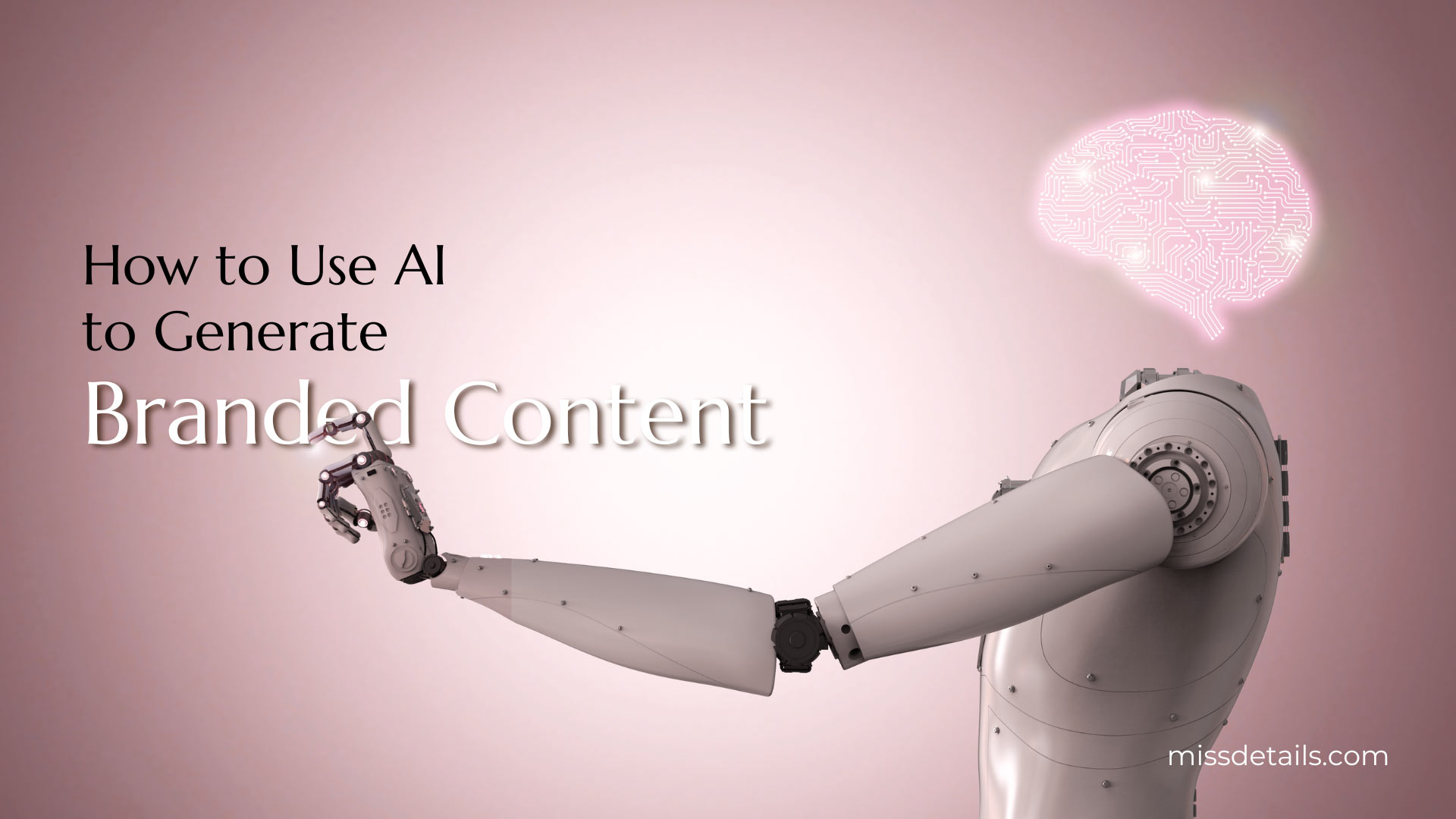As AI becomes more ubiquitous, one of its most frequent uses revolves around visual imagery. From image generation tools, like Midjourney, to branding platforms like Canva, it seems as if everyone is trying to find new ways to incorporate AI. Of course, within this new world comes a new set of questions. Top of mind is the ethics around using AI to generate branded content.
How can you make the most of the possibilities of AI without losing the soul of your brand, or unwittingly stealing from designers?
In this post, we’ll explore how you can use AI in a way that elevates your assets without damaging your brand—so you can decide whether it makes sense for you.

AI Generated Content: A Primer
Before we dig into how to generate AI-generated content, let’s talk about what it is. These days, it’s difficult to go far without hearing someone talking about how AI has infiltrated industries usually held by creators. Artists, designers, and writers have been impacted, as well as software developers, educators, and more.
In short, AI tools take in a prompt crafted by a human and use that information to produce a highly specific and detailed response—in the form of writing, images, code, video, and more.
Not only that, but AI continues to learn, pulling from an ever-growing data set. This means that AI can iterate on itself, constantly growing smarter and more accurate. A year ago, the average AI-generated image of a person tended toward too many fingers and an unsettlingly surreal appearance. Today, it’s hard to distinguish what AI creates from a real-life photograph.
So how do you face this brave new world? AI certainly isn’t going anywhere. In fact, many design tools like Canva and Adobe are already integrating them into their platforms. AI is here to stay.
So what are you to do, when faced with the opportunity to use AI in your branded content?
The Drawbacks of AI-Generated Brand Content
Despite the potential cost savings or creative output, the promise of AI also brings with it a few red flags. Many of the existing machine learning technologies, like Midjourney, rely on a database of existing artists’ work—often gathered without permission. The nature of AI tools involves using this work to “learn” how to create its own.
As you can imagine, this leads to a few concerns, including:
Plagiarism Issues
While AI may appear to generate original work, the tool must learn from somewhere. Typically, that learning takes place by ‘scraping’ existing artwork, photography, and illustration. The AI tool’s results, as a result, are heavily influenced by copyrighted works taken without ever getting the original artist’s permission.
With this technology still in its infancy, there are no firm laws regarding the use of AI, the gathering of data to teach AI, or the repurposing of AI-generated content. You can be sure this will change in the future.
Limited Creative Freedom
It may seem odd, but the expansive abilities of AI can actually limit your creativity. It’s simple to type a prompt into an AI tool. But unless you have a deep understanding of your brand and how to ask AI for what you need, you may find yourself with lackluster results that don’t reflect the nuance of your brand or connect with your audience.
Brand design runs deeper than a prompt. It connects data with emotion, intention with iteration. And as sophisticated as AI tools have become, they can’t read your mind. They can’t understand the depth of your brand or lean into the principles of sensory branding to amplify how it shows up in the world.
Inconsistencies and a Lack of Reliability
The learning mechanism of AI tools is incredibly complex, and its results are not always reliable. Creating a brand identity or full suite of brand assets is a difficult endeavor that requires consistency. While images and assets may look good in isolation, there’s no current system of checks and balances to make sure your brand is cohesive across the board.
The result? You risk creating a brand that’s forgettable, scattered, and blends into the background. And in today’s fast-paced world, where consumers are confronted with brand messaging constantly, it’s vital to make an excellent impression.
The Benefits of AI-Generated Brand Content
While the drawbacks of AI can be substantial, and they may never fully replace the human element, there are some areas where having the support of AI may help.
Some of the benefits presented of using AI to generate branded content include:
Brainstorming Tool for New Initiatives
There was a time when every new brand project began by creating a mood board on Pinterest. And while that particular method of finding your brand’s look and feel isn’t disappearing, AI tools take it to a new level.
You can use AI to generate branded content ideas that serve as a source of inspiration. From color palettes to stock photography, AI tools can plant the seeds for your next initiative. And then you can pass your new ideas on to a designer who can bring them to life.
Quick, Affordable Content Creation
Small teams and solopreneurs often operate on a limited budget while also needing to churn out work quickly. Thankfully, AI tools can take some of the weight off your shoulders. While we certainly don’t recommend relying on AI for everything, it can help with specific tasks, allowing you to quickly and affordably get new branded content underway.
AI tools may provide a quick fix, but they aren’t the only way to make the most of your marketing budget. Make sure you fully exhaust your options before deciding to leverage AI to generate branded content.
Expansion and Repurposing of Existing Assets
Digging a bit deeper into the idea of iteration, you can leverage AI tools to expand photographs and other imagery already owned by the company. Using your existing branded content as a foundation, you can develop a custom database of stock photos and illustrations unique to your company.
Artificial intelligence is a tool. When it’s treated as such, rather than as a replacement for your design team, it can become an incredible resource.
So how do you leverage AI-generated brand content in your business?
3 Steps for Generating Branded Content with AI
Using AI-generated content for your brand without including a human component (especially for quality control) is dangerous. But collaborating with AI tools, while leaning on experts in both branding and prompting, can bring about useful results.
Here are three steps you can take to tactfully use AI within your brand.
Step One: Understand Your Brand
While AI can be a useful tool for those who already have a clear understanding of their brand, it shouldn’t be relied on to create your brand.
Building a memorable brand takes work—and it’s so much more than a logo or a color palette.
Imagine this. You’re a realtor who needs to solidify your brand. You head to ChatGPT and type in, “I’m a realtor. I need a brand strategy for my business. Generate one for me.”
In fact, in the writing of this post we went and did exactly that. What did we receive? Information that wasn’t wrong, but also wasn’t unique. In fact, the results could have been applied to just about any business in any industry.
A more specific prompt may get you a slightly better result, but at the end of the day AI tools are still creating for the lowest common denominator. They’re programmed to give anyone who approaches them the response they want. As a result, you’re not going to find a system capable of building a truly authentic, unique brand for you.
So before you head to AI to generate branded content for you, make sure you’ve done the work to lay the foundation of your brand. This means understanding your positioning and your visual identity, and having it organized in an accessible way.
Step Two: Solidify Your Needs
Making use of AI tools begins with understanding why you’re using them. What need are you fulfilling? As mentioned above, AI won’t help you create a full-fledged brand. But when generating branded content, there are a few areas where AI emerges as a helpful tool.
A few of these areas include:
- Headshot Updates: If it’s been awhile since you had a branded photoshoot, you may be able to get extra mileage out of existing photos. While AI can’t replace a full-fledged brand shoot, you can get by for a time with an AI headshot generator like this one.
- Brand Color Inspiration: You’ll want to work with a designer for final approval, but AI tools can give you a great head start on the look and feel you’d like to emulate within your brand. You can use tools like Huemint to explore different possibilities.
- Stock Photography Inspiration: Similar to brand colors, using AI tools for stock photography can be useful. But tread carefully; make sure you’re crystal clear on your brand before you start investigating this route, so you don’t end up with something generic. In addition, there are no legal parameters in place to make sure your AI-generated photo isn’t learning from copyrighted sources. Instead of throwing your shiny new AI images up on your website, use them as a brainstorming tool to share with your own photographer.
- Content Repurposing: What if you could take one piece of branded content and use AI to generate twenty more? While visual repurposing isn’t as advanced yet as written repurposing, this is another area where you can investigate using content that already exists as a foundation.
Remember, AI is a useful tool, but it’s only a piece of the larger brand puzzle. It can’t fully create an emotional connection with your brand. So be specific in how you’re using it and know its limitations ahead of time.
Step Three: Prime Your Prompts
Generating branded content with AI can be a tricky process. As we’ve already discussed, the prompt you use matters. The more specific you are, the more specific your results. But sometimes you need to iterate on your prompting multiple times before the AI tool starts to understand what you need.
LearnPrompt.Org offers an entire free course dedicated to teaching you how to develop prompts for AI tools—including image prompts. It’s definitely worth digging into a resource like this if you plan to add AI tools to your strategy.
Once you’ve gotten the hang of prompting your preferred AI tool, it will be easier to get relevant results. However, keep in mind that machine learning technology is constantly changing. You’ll want to stay up to date with the latest strategies.
On top of that, it’s a good idea to run your results by someone who’s an expert in your brand (and in design). That way you can make sure you’re pulling images that fully reflect your company’s brand without diluting it.
Finalizing Your AI Branded Content Strategy
The world of artificial intelligence and machine learning continues to evolve. While the three steps above are general enough to apply to a variety of platforms and brand needs, keep in mind that they aren’t set in stone.
The most important aspect of using AI generation in your branded content is making sure it’s supporting your overall brand, instead of detracting from it. A human element is and always will be necessary for this step. Make sure you and your team understand your brand deeply, so you can review AI-generated assets with an eye for authenticity.
And when it comes to building a brand (or rebrand) from scratch, don’t cut corners. As of yet, AI cannot capture the heart and soul of a brand. It cannot understand the depth of your why or the hopes for your future. And even if it could, it would struggle to distill it into imagery that conveys the message to your audience.
Prepare Your Brand for AI with the Brand Checkup
Before you use AI to generate branded content, make sure you understand what your brand already has in place, what’s missing, and what needs a little extra attention and focus. This guide will help you continue down the road to brand perfection—and prepare you to prompt AI tools more effectively.
Don’t want to miss out on our articles and insights?
Sign up for the Miss Details newsletter today.



